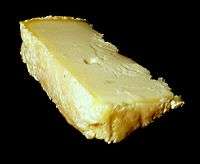Chabichou
| Chabichou | |
|---|---|
|
| |
| Other names | Chabichou du Poitou |
| Country of origin | France |
| Source of milk | Goats |
| Pasteurized | No |
| Texture | Soft |
|
| |
Chabichou (also known as Chabichou du Poitou) is a traditional soft, unpasteurized, natural-rind French goat cheese (or Fromage de Chèvre) with a firm and creamy texture.
Chabichou is aged for 10 to 20 days.
History
The legend of Chabichou goes back to 732, at the time of the defeat of the Arabs in the area, in the 8th century, after the Battle of Poitiers. Many of them left the area but some settled there with their families and, in particular, their goat herds. The countryside was appropriate for grazing the "poor man's cow", as the pastures were excellent. The cheese was then named cheblis (“goat”, in Arabic), which would become “chabichou" thereafter. However, the domestication of the goat in this area is supposed to date back to Roman colonization, and extends up to the present.[1]
Le Chabichou du Poitou
Chabichou du Poitou, made exclusively in the Poitou-Charentes region, acquired its AOC status in 1990 with the assistance of the efforts of Ségolène Royal. It is known for its characteristic label. Its production rose to 555 tons in 2003.
Since 1782, Chabichou du Poitou has been mentioned in the French "Guide du voyageur à Poitiers et aux environs". When regional wine production slowed in the late 1800s due to the European phylloxera crisis, production of Chabichou increased; production increased again with the development of the cooperative dairies (1906 in Bougon).

The AOC production zone is limited to an area south of Haut-Poitou: the south of Vienne, the Deux-Sèvres and the north of the Charente. See the official website of Chabichou du Poitou: http://www.chabichou-du-poitou.eu
Manufacture
Chabichou of Poitou is made of fresh and whole goat's milk. It is quickly but slightly pressurized: less than 100 microliters per liter of milk. They then let the milk coagulate during a 24-hour period between 20 and 22°C. This curd is then moulded manually with a ladle or mixer into perforated and truncated moulds and left to drain for another 18 to 24 hours while turning it over it two or three times, maintaining it at 22°C. Afterwards, they are removed from the moulds and salted with dry salt or sometimes in a brine bath. It is then laid out in drying rooms, i.e. it is drained while being placed in moulds for 24 to 48 hours. Afterwards it is left to mature in cellars at between 10 and 12°C and within 80% to 90% humidity. It remains there for at least 10 days, but generally for two or three weeks. Some are even preserved for months for a more vigorous flavor.
Analysis
Chabichou is very white and smooth, and flexible to the palate, with a fine caprine odor. Immature Chabichou of Poitou can be enjoyed with a white wine such as Sauvignon blanc, particularly one from the same region. But more mature Chabichou is better with a red wine from the region, an aperitif or a Pineau des Charentes.